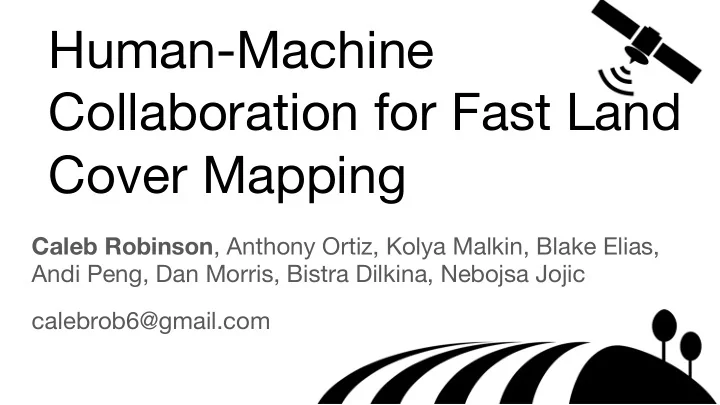

Human-Machine Collaboration for Fast Land Cover Mapping Caleb Robinson , Anthony Ortiz, Kolya Malkin, Blake Elias, Andi Peng, Dan Morris, Bistra Dilkina, Nebojsa Jojic calebrob6@gmail.com
Collaborators Anthony Ortiz - University of Texas at El Paso Kolya Malkin - Yale University Blake Elias - Microsoft AI Resident Andi Peng - Microsoft AI Resident Dan Morris - Microsoft AI for Earth Bistra Dilkina - University of Southern California Nebojsa Jojic - Microsoft Research
What is the land cover mapping problem?
1 pixel = 1 meter squared High-Resolution Satellite/Aerial Imagery NAIP 2013/2014 4
Water Forest Field Built High-Resolution Land Cover Map Chesapeake Conservancy 5
Why do we need high resolution land cover maps?
E.g. to help inform conservation actions Riparian buffers “[The Chesapeake Conservancy] leverages the combination of the enhanced flow path data and high- resolution land cover data to identify opportunity areas for planting riparian forest buffers within a specified distance of the flow paths.” 7 https://chesapeakeconservancy.org/conservation-innovation-center/high-resolution-data/enhanced-flow-paths/
But...
(Semi-) Manual labeling is expensive Chesapeake Conservancy Unlabeled - 98% of area - many time points - 40.8 years? Labeled - $63.7 million? - 2% of area - 1 time point - 10 months - $1.3 million 9 https://chesapeakeconservancy.org/conservation-innovation-center/high-resolution-data/
Deep learning approach to land cover mapping High-resolution input CNN High-resolution predictions Image from: "U-net: Convolutional networks for biomedical image segmentation."
Problems in generalization Attempt to get good model performance in remainder of US Previous work in ICLR 2019 and CVPR 2019 11
And over We have 1m here... labels here But need labels here... ● Different organizations ● Different class definitions ● Different imagery
Potential Approaches 1. Revisit assumptions - Try different modeling approaches Local stakeholders - Retrain model with different hyperparameters can not do this - Retrain model with different data (not scalable) - … 2. Fine-tune existing model with new Local stakeholders data can do this - Query labelers for new data (scalable) - Adapt model accordingly 14
How can models trained in one area be quickly adapted to work in other areas? Assumption : New York - We have an existing model - We can solicit humans to label data points in the other areas Maryland
Active learning Class entropy approach Random Query method ... Model inference Labeling Last layer Retraining parameters ...
Modeling humans in-the-loop Query method Human intuition can be Model used in sample selection inference too! Labeling Retraining
Implementation of humans-in- the-loop
http://msrcalebubuntu1.eastus.cloudapp.azure.com:8080/
Experimental Setup Base UNet model trained on data from Maryland (where we have high-resolution ground truth labels) 4 different 84km 2 areas in New York (where we have high-resolution ground truth labels) Base model 27
Experiment Setup ● Offline study Compare a variety of { active learning } x { fine-tuning methods } for ○ adapting a model to a new area ● Online study with crowdsourced workers Compare best(ish) active learning strategy against human labelers in our ○ tool
Methods - All Query methods: ● Random ● Entropy (where model is uncertain about the class) ● Min-margin (where model is uncertain about the class) ● Mistakes (where model makes mistakes) ● Human (where a human labeler wants) Fine-tuning methods: ● Last- k -layers Which combination of query ● Group norm parameters method and fine-tuning method ● Dropout is best? 29
Methods - Offline study Query methods: ● Random ● Entropy (where model is uncertain about the class) ● Min-margin (where model is uncertain about the class) ● Mistakes (where model makes mistakes) ● Human (where a human labeler wants) Fine-tuning methods: ● Last- k -layers ● Group norm parameters ● Dropout 30
Results - Offline study With Last 2 layers fine-tuning method With Random query method - All methods are showing improvements with additional points added - Random and Min-Margin are the best performing query methods - Last-k-layers is the best performing fine-tuning method 31
Methods - Online study Query methods: ● Random ● Entropy (where model is uncertain about the class) ● Min-margin (where model is uncertain about the class) ● Mistakes (where model makes mistakes) ● Human (where a human labeler wants) Fine-tuning methods: ● Last- {1,2} -layers ● Group norm parameters ● Dropout 32
Experimental Setup - Online study For a Human ● Randomly order the 4 areas ● User spends 15 minutes fine-tuning in each area ● Model is reset between 15 minute sessions Base model 33
Results - Online study - On average users are outperforming Random selection of fine-tuning points - Some users are much better 34
User behavior Users pick more points from mid- model entropy ranges Users pick fewer points from low- model entropy ranges 35
User behavior Users always pick points that are close to an edge in the imagery 36
Summary ● Proposed modeling human-in-the-loop methods in an active learning framework ● Compared different query methods and fine-tuning methods for adapting land cover models to new areas ● Performed an online study comparing Human query method to Random selection ● We find that users outperform random selection and behave distinctively different from other query strategies ● Local stakeholders can use our interface and methodology to tune existing models to new areas that they care about * 37
People / Papers / Code / Data https://aka.ms/landcovermapping Publications - Label Super-Resolution Networks . ICLR 2019. - Large Scale High-Resolution Land Cover Mapping with Multi-Resolution Data . CVPR 2019. - Human-Machine Collaboration for Fast Land Cover Mapping . AAAI 2020.
Recommend
More recommend